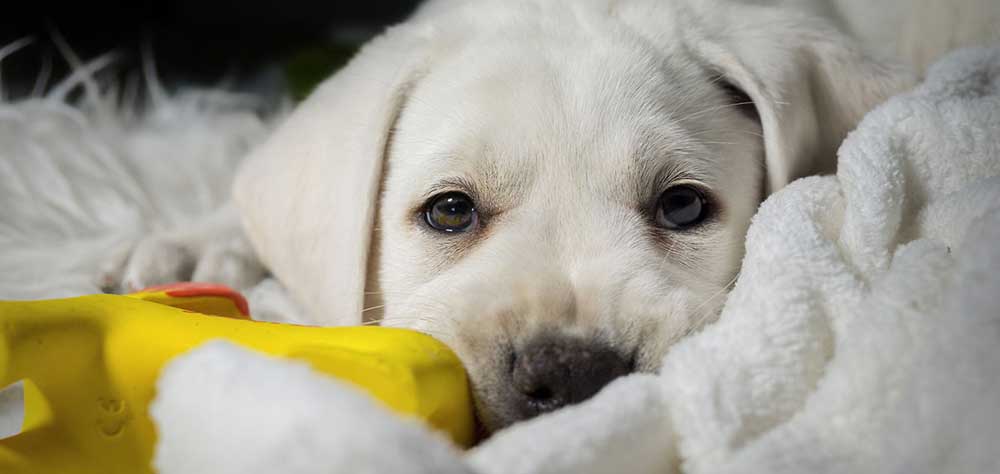More
It's important to monitor your dog's comfort level and health, such as hypothermia, frost bite and injury, while walking in cold weather.
More
Next time you throw on a thick jacket and gloves for a chilly walk, consider whether or not your dog has enough layers too!
Whether it's a dusting of snowflakes or two feet of powder, some dogs are obsessed with snow like kids on a snow day. Northern breeds and cold-weather dog breeds with thick double coats, such as Malamutes, Tibetan Mastiffs, Siberian Huskies, Newfoundlands and Samoyeds, were bred for frigid climates. (You can find out more about cold-weather dog breeds here.) These fluffy dogs are insulated to tolerate snowy hikes and stay active in below-freezing temperatures.
Many dog breeds however, have only one coat which makes them susceptible to health risks when exposed to cold weather. Age and size also plays a factor in a dog's tolerance to the cold.
If you love to adventure on wintery days, it's important to monitor your dog's comfort level while exploring in these conditions. When walking your pup in chilly weather, keep these health precautions in mind!

Frostbite
Did you know dogs are at risk for frostbite too? Dogs' ears, nose, tail tip, and prepuce are most at risk to frostbite. Just like the human body, a dog's natural response to preserving heat near the vital organs is to reduce blood flow to the extremities. Long periods of absent or reduced blood flow can cause serious injury to these extremities.
Symptoms:
Signs that your dog is experiencing frostbite includes coldness of the area when touched, and pain and swelling as those affected areas warm up. Look for pale, blue-ish or gray discoloration of the skin on their extremities, skin ulcers or blisters, and blackened or dead skin appearing days after exposure.
Prevention:
To prevent your dog from frostbite, avoid prolonged exposure to cold and windy conditions and be aware of your dog's comfort level. A dog jacket or vest can provide an additional warm layer to maintain their core temperature.

Hypothermia
According to Mayo Clinic, "hypothermia is a medical emergency that occurs when your body loses heat faster than it can produce heat, causing a dangerously low body temperature." When a dog’s core body temperature drops below 95℉, it can become a life-threatening situation. Dogs who are outside for long periods while exposed to wet or windy weather, who are tired, or standing in one place, are most at risk.
Symptoms:
Signs of hypothermia in dogs include strong shivering followed by no shivering, acting sleepy or weak, and fur and skin that feel cold to the touch. Dogs may develop pale gums, decreased heart rate, trouble walking and eventually unconsciousness as hypothermia progresses. Take your dog to a veterinarian immediately if he/she seems lethargic or is unresponsive.
Prevention:
In cold, windy and or wet weather, consider covering your dog's core and exposed belly with a dog jacket or vest. Pay attention to sudden changes in weather, take breaks sheltered from the wind and snow, and monitor your dog for shivering.

Injuries
Foot injuries are fairly common in winter conditions. Dogs’ feet can develop abrasions to the paw pads and torn nails from rough snow and ice. Walking on road salt and de-icer can burn or irritate your dog’s paws and skin.
Symptoms:
Look for blood on the snow or ground if you suspect a laceration. Inspect your dog's paws and nails if he/she is limping, as this is the most common sign of foot injuries. Tendon or ligament injuries are a possibility when no external wounds are visible.
Prevention:
You can protect your dog's paws from snow, ice and rock salt with dog boots or paw wax. Try to avoid areas known for using ice-melt chemicals and be sure to wash your pup's paws after a walk if his/her paws are exposed. Be sure to look for pet-safe ice melting products if you use de-icer at home.
Unexpected situations can happen anytime, anywhere. Although you may not know how to respond to every incident, you can still prepare yourself by having essential medical supplies close by. Here are the essentials to include in a DIY canine emergency first-aid kit.
Cheers to more winter adventures with your powder hound! Have fun and stay safe out there!

Photo Credit: All Images from Canva.com
Sources: https://www.mayoclinic.org/diseases-conditions/hypothermia/symptoms-causes/syc-20352682
https://www.medvetforpets.com/treatment-of-hypothermia-in-dogs-and-cats/




